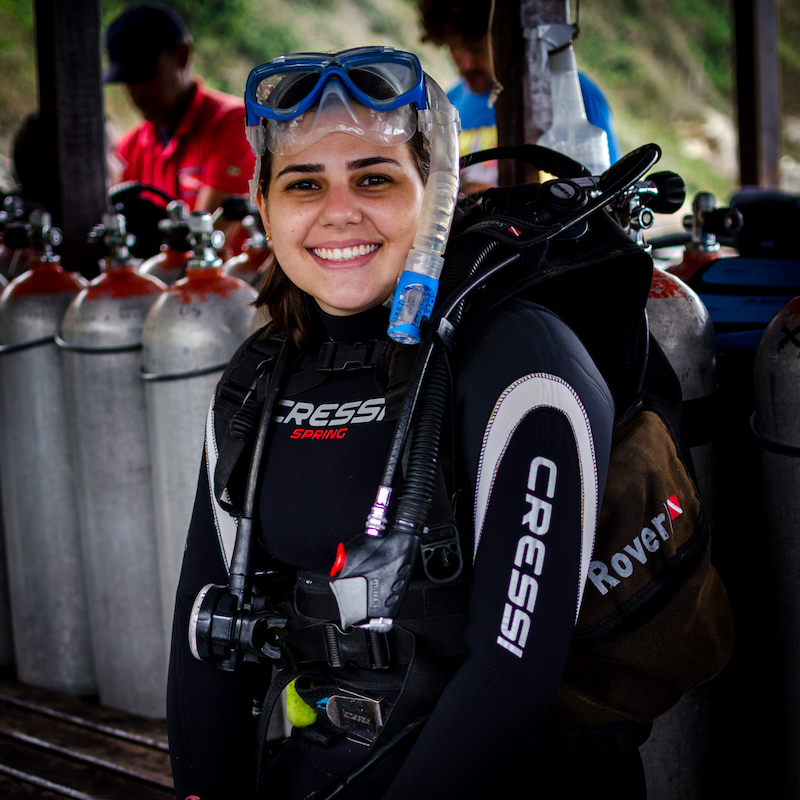PeerJ spoke to Vanessa Bettcher about the recently published article Habitat-use of the vulnerable Atlantic Nurse Shark: a review.The article was published as part of the IABO Hub. The IABO Hub is the publishing home of the International Association for Biological Oceanography, and features the latest biological oceanography research published by the members of IABO.
Can you tell us a bit about yourself?
I am a PhD candidate in the Ecology and Evolution graduate program of the Rio de Janeiro State University in Brazil. My research focuses on the conservation of elasmobranchs by evaluating demographics and populational descriptors. I have been applying photo-identification to evaluate local populations of the Atlantic Nurse Shark at the South Atlantic to estimate population size and structure, as long as their relation with habitat. My thesis aims to provide valuable insights into the species’ spatial distribution and ecological determinants of habitat use at different scales. The present work is an integral part of this objective.
Can you briefly explain the research you published in PeerJ?
Our paper is an outcome of my doctoral research and was conducted through a partnership with a dear collaborator who has been supporting me throughout this phase, Dr. Ana Clara Sampaio Franco, as well as my advisor, Dr. Luciano Neves. As we know, human activities have led to the rapid loss of critical habitats for aquatic species, to the extent that habitat modification is considered one of the primary threats to biodiversity, second only to fishing for sharks. Therefore, this study aimed to gather and provide information on the global distribution and habitat associations of the recently listed as “vulnerable”, the Atlantic Nurse Shark (Ginglymostoma cirratum) to highlight critical habitats for this species’ conservation. A literature review was performed, and 30 studies published between 1950 and 2021 were retained since they defined at least the type of habitat in which G. cirratum was associated, highlighting the role played by reefs.
What did you discover and where?
Most studies covered the Floridian ecoregion, where G. cirratum is more common and abundant. Reefs, seagrass, sandy, rocky, mangrove, and macroalgae accounted for most habitat associations, with a higher diversity of habitats detected within marine protected areas (MPAs). Ginglymostoma cirratum was recorded at a maximum depth of 75 m, temperatures ranging from 25 to 34 ºC, and salinities between 31 and 38 ppt. Neonates were associated with shallower habitats (< 20 m), mostly reefs, rocks, macroalgae, sandy shores, and seagrass, in an average temperature of 26 ºC and salinity of 36 ppt. Breeding events and habitats were reported by 11 studies, 72.7% of them in shallow waters, mostly inside MPAs (90.9%).
What was significant about your findings?
Our findings highlighted the key role played by MPAs in protecting essential grounds for threatened species, such as the Atlantic Nurse Shark. Populations were commonly associated with shallow, coastal, warm, and saline waters in the studies retained herein. We also find that major ecoregions (e.g., the Eastern Atlantic) are still underrepresented in the scientific literature as well as studies that aim specifically to assess G. cirratum habitat association. Critical habitats for neonates and breeding sites are yet to be identified in Northeastern Brazil, and Guianan ecoregions. Thus, further insights into the essential habitats are needed to implement effective conservation measures for the Atlantic Nurse Shark, such as creating new MPAs that encompass critical habitats and fishing restriction measures and closing access in certain areas, such as during reproductive events.
How did you first hear about PeerJ, and what persuaded you to submit to us?
I first heard about PeerJ during my undergraduate when I still dreamed of working with non-lethal methods to study sharks and I read many quality papers published in the journal. When I heard about the call for The International Association for Biological Oceanography Hub from a colleague in my Graduate Program, I was immediately interested in participating and submitting my work.
How was your experience publishing an article in the IABO hub?
It was a great experience publishing with PeerJ. The IABO Hub was a great initiative to open science from developing countries.
PeerJ Hubs are a new concept providing a sustainable Open Access solution for societies and research associations, with meaningful benefits for members. Whether your organization wants to launch its first publication, or is seeking a fully OA, funder-compliant option to complement your existing journals, a Hub could grow and develop your community, and make Open Access a more attainable and equitable option for your members.
Best of all, Hubs are free for organizations to launch!
If you are interested in discussing a Hub for your society or research association, please email [email protected] and we can send you further information.


